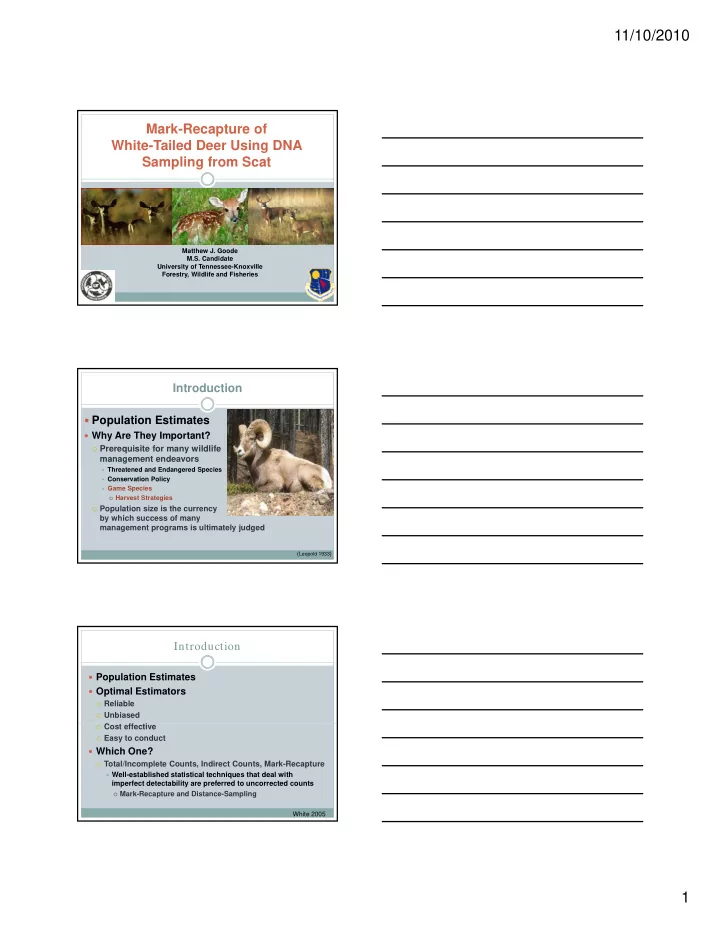

11/10/2010 Mark-Recapture of White-Tailed Deer Using DNA Sampling from Scat Matthew J. Goode M.S. Candidate University of Tennessee-Knoxville Forestry, Wildlife and Fisheries Introduction � Population Estimates � Why Are They Important? � Prerequisite for many wildlife management endeavors � Threatened and Endangered Species � Conservation Policy � Game Species � Harvest Strategies � Population size is the currency by which success of many management programs is ultimately judged ( Leopold 1933 ) Introduction � Population Estimates � Optimal Estimators � Reliable � Unbiased � Cost effective C t ff ti � Easy to conduct � Which One? � Total/Incomplete Counts, Indirect Counts, Mark-Recapture � Well-established statistical techniques that deal with imperfect detectability are preferred to uncorrected counts � Mark-Recapture and Distance-Sampling White 2005 1
11/10/2010 Introduction Population Assessment Techniques Population Estimation Indices Methods All Objects All Objects All Objects All Objects Constant Constant F Frequency Observed Not Observed Proportion Complete Census on Observations Captures Census Sample Plots Detection Double Distance Capture Mark Probability Removal Recapture Sampling Sampling Models Invasive Non-Invasive Non-Selective Selective Introduction � Mark-Recapture � General Assumptions � Population is closed to additions and deletions � Marked and Unmarked animals are equally vulnerable to capture � Marks are not lost or overlooked � Non-Invasive vs. Invasive � Marker � Behavior Introduction � Population Estimates � Why White-Tailed Deer? � Keystone Species � Competition � Altering Habitat � Most economically important � Most economically important big-game mammal in North America � Pittman-Robertson Act � Crop Damage � Deer-Vehicle Collisions � Game Species (Schaefer and Main 2001) 2
11/10/2010 Justification � Economic and Environmental Importance of White-Tailed Deer � Population Estimates are the basis for most management protocols � Managers need reliable techniques that minimize assumptions and biases � Lost Marks � Equal Catchability � Closed Population � Scat � Randomly Dispersed Goal � Determine if genetic markers from scat can give reliable population estimates 1 2 3 4 5 Goal: Can genetic markers from scat produce population estimates O B J E C TI V E 1 - D E N S I TY Evaluate the potential for genetic markers from scat to estimate density ti t d it O B J E C TI V E 2 - S E X R ATI O S Evaluate the potential for genetic markers from scat to estimate sex ratios O B J E C TI V E 3 - H O M E R AN G E S Evaluate the potential for genetic markers from scat to estimate home ranges 3
11/10/2010 Study Area Arnold Air Force Base AEDC WMA Coffee and Franklin County, Tennessee ~16,000 hectares ~8,500 ha Hardwoods ~3,000 ha Pines ~1,500 ha Open Fields Study Area 1 km 2 Area ~50 ha Hardwoods ~40 ha Pines 4 ~10 ha Fields Scat Sampling Capture Events 5 Capture Events Capture Event= 2 days 150 random plots per capture event capture event 750 Total Plots Plots were sampled: Jan 11, 2010-Jan 21,2010 4
11/10/2010 Scat Sampling Why 150 Plots? � Recapture � Need for 20% Recapture � Need at least 20% � ~30 pellet groups/capture event � Preliminary � 20% success � 20% success � ~8 deer/km 2 8 deer/km 150 Plots/ Capture Event � ~10 pellet groups/deer/day � ~160 pellets groups/ capture event N Scat Sampling Plots Plots were generated in Arc Map and located using GPS “keeper” 10 m radius circle plots plots W W E E Flagged at center 10m point and at cardinal directions Pellets 0.1m2 from center of group will not be collected S Scat Sampling Collection Latex Gloves Placed in Paper Bags Labeled: Date, Plot #, Sample #, and Ranking d R ki Stored: Open Air Containers Desiccant added Sent to Wildlife Genetics International to be analyzed 5
11/10/2010 Genotyping Wildlife Genetics International QIAGEN’s Dneasy Blood and Tissue Kits ATL digest buffer Individual Genetic Profiles 6 microsatellites Gender Determination ZFX/ ZFY gender marker Analysis � Program DENSITY � Uses encounter histories similar to Program MARK but also incorporates spatially explicit mark-recapture locations � Allow us to obtain estimates of home ranges and population density unbiased by edge effects and incomplete detection y y g p Analysis 6
11/10/2010 Aknowledgements � Committee members: � Drs. Lisa Muller, Craig Harper, Joe Clark, Frank van Manen � Funding Agencies � FWF, UTIA Ag Innovation, DoD, USFWS � Rick McWhite, AAFB Natural Resource Manager � Wes Winton, AEDC WMA Manager � Jared Beaver, Fellow Grad Student � Technicians � Ashley Unger, Marcus Mustain, Sandra Nash, Shane McKenzie Questions? 7
Recommend
More recommend